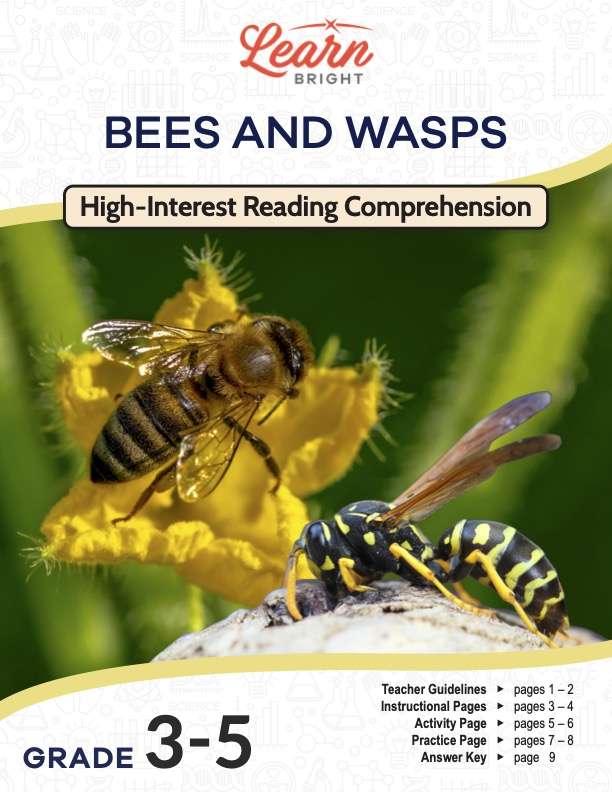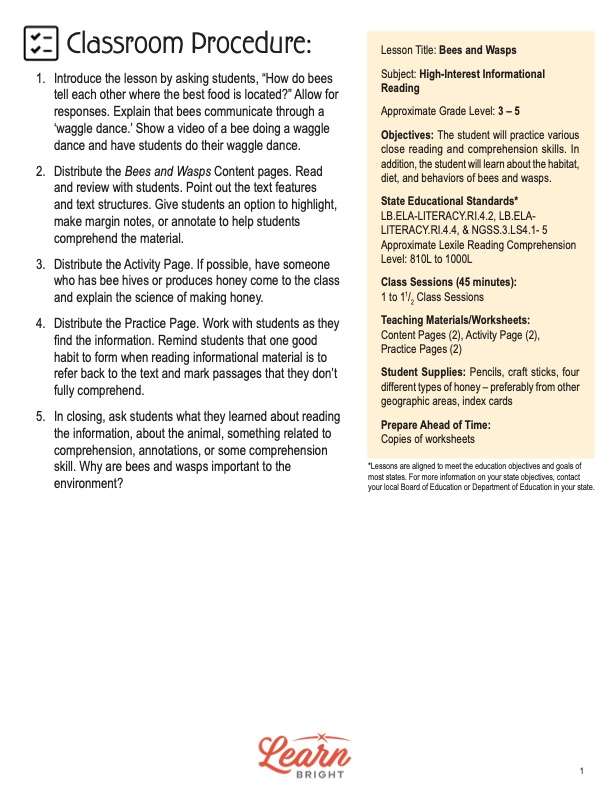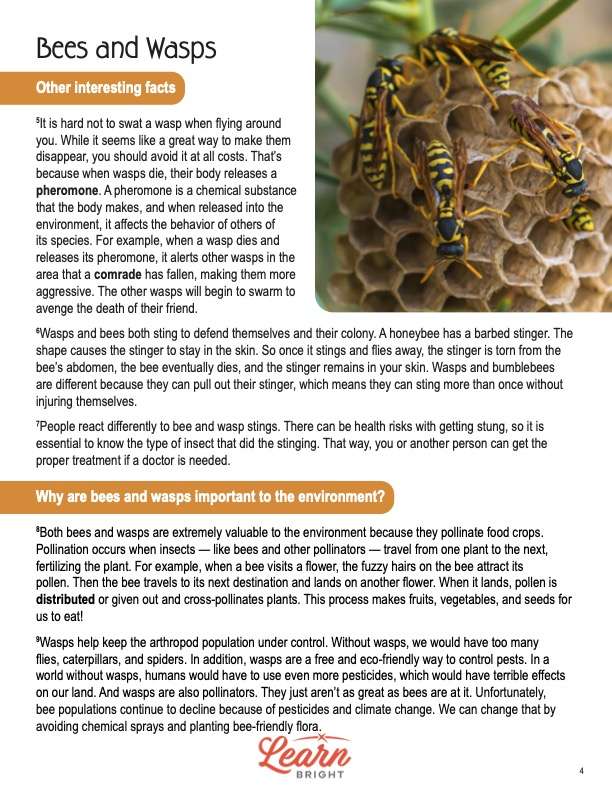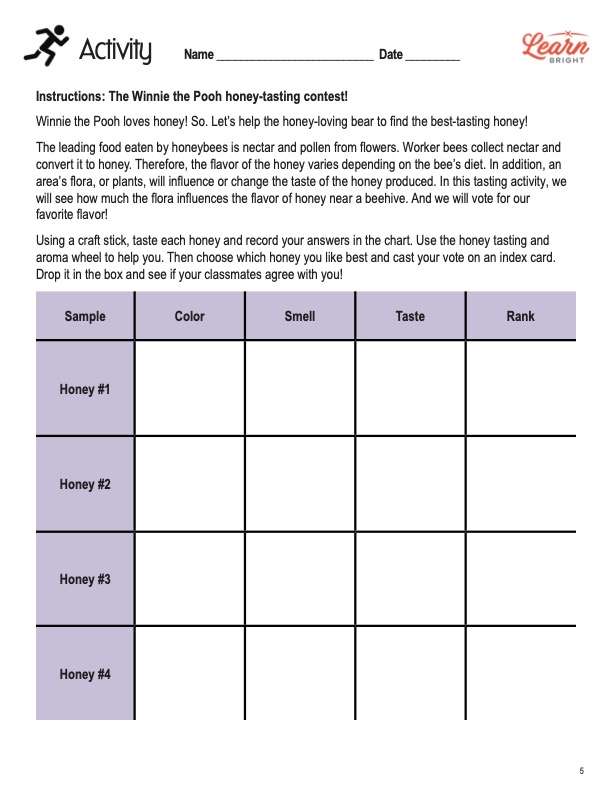Description
What our Bees and Wasps lesson plan includes
Lesson Objectives and Overview: Bees and Wasps is a high-interest reading comprehension lesson plan. As such, students will practice various close reading and comprehension skills. In addition, they will learn about these insects’ habitat, diet, and behaviors. This lesson is for students in 3rd grade, 4th grade, and 5th grade.
Classroom Procedure
Every lesson plan provides you with a classroom procedure page that outlines a step-by-step guide to follow. You do not have to follow the guide exactly. The guide helps you organize the lesson and details when to hand out worksheets. It also lists information in the yellow box that you might find useful. You will find the lesson objectives, state standards, and number of class sessions the lesson should take to complete in this area. In addition, it describes the supplies you will need as well as what and how you need to prepare beforehand.
Teacher Notes
The teacher notes page provides an extra paragraph of information to help guide the lesson and remind you what to focus on. It explains that you can teach this lesson in a whole-class setting or to an independent, small group as an activity. The blank lines on this page are available for you to write out thoughts and ideas you have as you prepare the lesson.
BEES AND WASPS LESSON PLAN CONTENT PAGES
The Difference between Bees and Wasps
The Bees and Wasps lesson plan contains two content pages. To start off, it provides a small box with basic background information about these insects. Bees and wasps are both types of insects that live all over the globe, except in Antarctica. Their diets include insects, plants, fruit, nectar, and honey. A bee can live from 30 to 60 days, but a wasp can only live between 12 and 22 days.
Even for the experts, it is hard to tell the difference between a bee and a wasp. But there are a few ways you can try to differentiate between them. First, you can look at their appearance. Bees have fuller bodies and flat legs, and they are hairy, making them appear fuzzy. Their fuzzy body helps them collect, disseminate, or spread pollen widely. Wasps have slimmer bodies but narrow legs and smooth, shiny bodies.
Bees make their nests from wax while wasp nests are made from paper-like materials, such as chewed wood. Honey bees are perennial insects, which means they can last very long. The nest can remain active for many years if the colony is healthy. Bumble bees and wasps only live in their nests for one year. This is because they have annual life cycles. But both bees and wasps are social creatures and live in colonies.
What They Eat
Bees and wasps also differ in what they choose to eat. Bees consume plant pollen and nectar from flowering plants. Nectar is a sweet fluid that flowers produce and that worker bees gather. The nectar provides energy, and the pollen provides protein and other nutrients. To make one teaspoon of pollen, a bee has to work eight hours a day for a whole month. Talk about being as busy as a bee!
Wasps are natural predators that feed arthropods and insects to their young. They are aggressive hunters and will leave their nest to look for food specifically. But during the late summer and fall, wasps focus on collecting sweets. However, this is not their primary food source, which is why you will see them most often during your outdoor activities at this time, especially if you have candy or sodas.
Other Interesting Facts
It is hard not to swat a wasp when it flies around you. While it seems like a great way to make them disappear, you should avoid it at all costs. This is because when wasps die, their body releases a pheromone. (A pheromone is a chemical substance that the body makes.) When released into the environment, it affects the behavior of others of its species. For example, when a wasp dies and releases its pheromone, it alerts other wasps in the area that a comrade has fallen, making them more aggressive. The other wasps will begin to swarm to avenge the death of their friend.
Wasps and bees both sting to defend themselves and their colony. A honey bee has a barbed stinger. The shape causes the stinger to stay in the skin. So once it stings and flies away, the stinger is torn from the bee’s abdomen. The bee eventually dies, but the stinger remains in your skin. Wasps differ from bumble bees because they can pull out their stinger, which means they can sting more than once without injuring themselves.
People react differently to bee and wasp stings. There can be health risks with getting stung, so it is essential to know the type of insect that did the stinging. That way, you or another person can get the proper treatment if a trip to the doctor is necessary.
Why They Are Important
Both bees and wasps are extremely valuable to the environment because they pollinate food crops. Pollination occurs when insects—like bees and other pollinators—travel from one plant to the next to fertilize it. For example, when a bee visits a flower, the fuzzy hairs on the bee attract the flower’s pollen. Then the bee travels to its next destination and lands on another flower. When the bee lands, it distributes pollen and cross-pollinates the plants. This process makes fruits, vegetables, and seeds for us to eat!
Wasps help keep the arthropod population under control. Without wasps, we would have too many flies, caterpillars, and spiders. In addition, wasps are a free and eco-friendly way to control pests. In a world without wasps, humans would have to use even more pesticides, which would have terrible effects on our land. And wasps are also pollinators. They just aren’t as great at it as bees are. Unfortunately, bee populations continue to decline because of pesticides and climate change. We can change that by avoiding chemical sprays and planting bee-friendly flora.
BEES AND WASPS LESSON PLAN WORKSHEETS
The Bees and Wasps lesson plan includes two worksheets: an activity worksheet and a practice worksheet. Each one will help students solidify their grasp of the material they learned throughout the lesson. You can refer to the classroom procedure guidelines to know when to hand out each worksheet.
HONEY TASTING CONTEST ACTIVITY WORKSHEET
The leading food that honey bees eat is nectar and pollen from flowers. Worker bees collect nectar and convert it to honey. Therefore, the flavor of the honey varies depending on the bee’s diet. In addition, an area’s flora, or plants, will influence or change the taste of the honey bees produce. For the activity, students will see how much the flora influences the flavor of honey near a beehive.
First, they will taste each of four flavors of honey by dipping craft sticks into each sample. They will record what the color, smell, and taste was of each flavor. The aroma wheel on the second worksheet page will help them identify good descriptors for each honey flavor. Then they will rank the four from best to worst and write their favorite one on an index card. You can gather the votes and show the class which flavor was most popular.
BEES AND WASPS PRACTICE WORKSHEET
The practice worksheet requires students to answer a series of 11 questions. These questions all relate to the content pages, so students will need to refer to them often for the answers. In addition, each question provides which reading tool the question corresponds to, such as text feature, vocabulary, or comprehension.
Worksheet Answer Keys
At the end of the lesson plan document is an answer key for the practice worksheet. The correct answers are all in red to make it easier for you to compare them with students’ responses. If you choose to administer the lesson pages to your students via PDF, you will need to save a new file that omits these pages. Otherwise, you can simply print out the applicable pages and keep these as reference for yourself when grading assignments.










